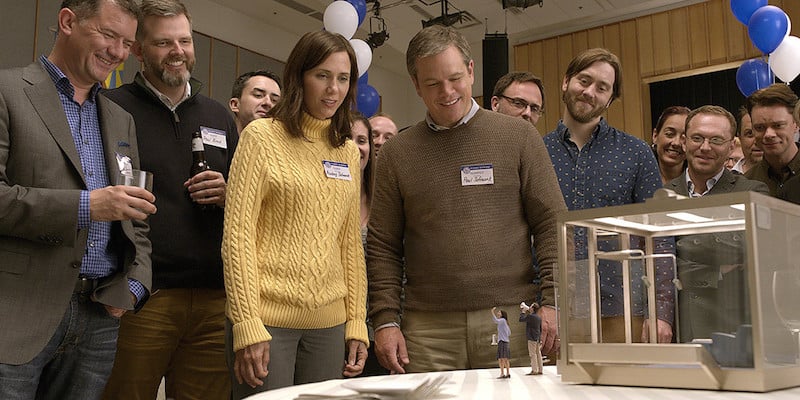
Jim Carey or Seth Rogen could make a shrinking movie that’s a straight comedy (Paul Rudd even did, though it was a superhero movie too). Alexander Payne made a shrinking movie that’s more interested in the actual social impact of shrinking people voluntarily, and in theory I’m for that. Yet Downsizing is not the arthouse version of a high concept studio comedy. It’s just another meandering indie that’s never really sure of its point.
Scientists have discovered a way to shrink people by a magnitude of 2744 times, so they create less waste and can consume fewer resources. As a side effect and selling point, it also makes middle class Americans rich if they choose to downsize because their money is worth 10 times as much relative to smaller items like houses. Paul (Matt Damon) and Audrey Safranek (Kristen Wiig) decide to downsize and move to Leisure Land so they can rest financially.
Payne and co-writerJim Taylor thought through the process of downsizing to make it scientific and socially believable as something people would do. They should have focused more on the actual story and themes they were expressing through this premise. The fact that there are five time jumps indicates how Downsizing skips over all the interesting parts. The resistance to the process probably happened during the 10 year jump. Marital conflict is very fertile and could certainly be exacerbated by such a paradigm shift, but that too is buried in a one year time jump.
They introduce something really big 30 minutes from the end, when it’s already too late to keep piling more tangents onto this story. Downsizing doesn’t even commit though, because a few minutes later other characters reveal the big revelation actually isn’t that big a deal. Both discoveries are made through exposition. Paul doesn’t even see it on the news, which would be the laziest possible way to deliver information cinematically but still preferable to exposition.

I could say they should’ve downsized the plot, but it’s not a matter of length, rather the misguided directions in which it goes. Instead of continually introducing new things, there was more to explore in the small colonies’ place in the big world and the big world coping with these new communities.
Heck, they already established that some some big folks resent the small. Go further with that. They establish that there are safety protocols for the small to travel in the big world, so don’t keep Paul in Leisure Land the whole time. There’s got to be more to travel than just safety glass and megaphones. Airlines lose luggage. We’re expected to believe they’ve had no accidents with tiny passengers? We hear that big restaurants charge small customers a minimum to make up for how little they eat. SHOW US some of the other sacrifices small people made in order to claim their riches.
What is security like in these small communities? Do they have a problem with big criminals trying to come in and stomp on small people? I know this isn’t the sci-fi B-movie version of shrinking people but if the world is going to take downsizing seriously as a way to stretch resources, they’ve got to consider the morbid possibilities too. This process puts an awful lot of trust in big people to be honorable.
One area Downsizing does explore is the poor area of the small world. They’re the ones who’ve had downsizing accidents, do practical jobs the rich don’t want and still struggle to survive. It goes to show that even a scientific and technological advance will be built on the backs of the poor, but you know, if that’s poignant to you, remember we still have poor communities in our real world. Maybe help them out a little instead of feeling sorry for them.
Ngoc Lan Tran (Hong Chou) is a Vietnamese immigrant. Downsizing admits that shrinking could create an even deadlier version of border crossing, but only pays lip service to the possibility of terrorist attacks from small enemies. A single movie doesn’t have to address everything, but don’t keep introducing new things that are less interesting than the things you’re ignoring.

Downsizing touches on how the rich get richer by bootlegging big items as many, many small ones. Leisure Land sells such a convincing package about how big a house and how sparkling a diamond you can buy there for $83, I kept waiting for the film to reveal the catch that Paul and his neighbors fell for. I know that in real life anyone selling something that enticing is hiding something, but Payne and Taylor didn’t seem to think so. They touch on the poor who ended up there, often against their will, but Paul should discover that nothing is free.
The digital composites whenever big and small people interact are glaring. If the whole movie were full of those interactions I would understand digital is the most cost effective way to pull it off. Since so little of the movie takes place in the big world, they could have afforded to do some old school forced perspective shots. Now those scenes just look like the hobbits in Lord of the Rings. The sound mix is good though. When small people talk they are just subtly lower pitched than the big dialogue.
Perhaps the biggest reason Downsizing is so irritating is that all the material was there to make a great film. There was a relevant premise/metaphor, a prestigious team to take it seriously and the means to make it look as good as a mega budget summer tentpole. Downsizing is a failure of imagination, not of proficiency.
Downsizing opens December 22.